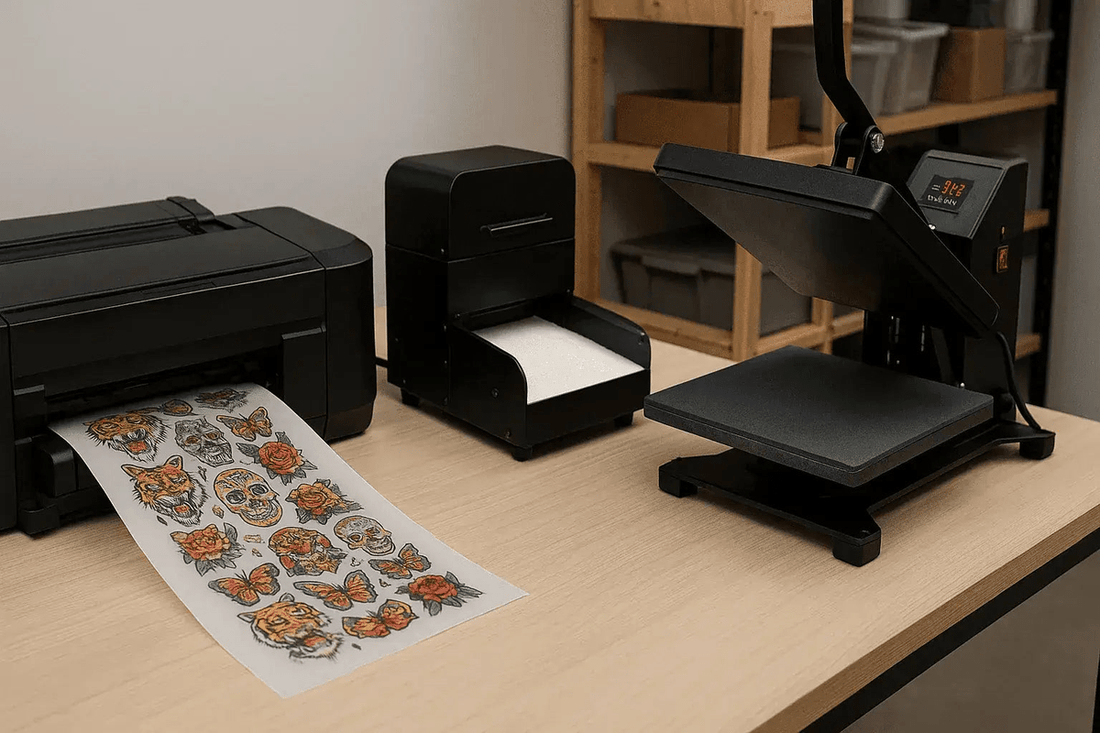Do I Need a Special Printer for DTF?
Direct-to-Film (DTF) printing depends on a printer engineered for DTF pigment inks (CMYK + White), stable white ink circulation, and consistent media handling. Consumer inkjets lack continuous white ink agitation and maintenance automation, which leads to downtime and clogged nozzles. Purpose-built DTF systems integrate white ink recirculation, automated cleaning cycles, and roll support for uninterrupted production — critical if you plan to scale (see printer insights in Best DTF Printers Guide and Ultimate Guide)
Key Advantages of a Dedicated DTF Printer
- White Ink Circulation: Maintains opacity and reduces sedimentation (guides above).
- Automated Maintenance: Cuts manual purges and wasted ink.
- Roll / Wider Format Support: Enables gang sheets and higher throughput.
- Predictable Uptime: Faster ROI vs. frequent DIY stoppages.
Can I Turn My Existing Printer into a DTF Printer?
Yes—some users retrofit select desktop printers with DTF inks and RIP software. However, without engineered white ink recirculation and automated cleaning, you’ll perform frequent manual nozzle checks, shaking, and environment control. Expect:
- Higher risk of clogs & banding.
- Void warranties / limited parts support.
-
More trial-and-error waste (film, powder, ink).
DIY may suit experimentation or hobby volumes; business production typically outgrows it quickly (compare downtime economics in the “Best DTF Printers” and “Ultimate Guide” articles).
Is Converting a Printer to DTF Worth It?
Short answer: Usually not for sustained commercial output.
A converted desktop might lower initial cash outlay, but hidden costs (extra maintenance hours, failed prints, replacement heads) shrink the gap. If you lose even 1 hour per day to manual recoveries versus a dedicated system running smoothly, the lost production often eclipses monthly financing on a professional unit.
Required Core Equipment for a Reliable DTF Workflow
|
Stage |
Essential Gear |
|
Printing |
Dedicated DTF printer (choose model based on width & speed) |
|
Inks |
Quality DTF CMYK + White inks (liter packaging for economy) |
|
Heat Application |
Accurate, even-pressure heat press |
|
Supplies (Films, Powders, etc.) |
PET films, adhesive powder, cleaning solution, maintenance swabs, parchment/silicone sheets |
|
Education/Optimization |
Tutorials & best practices |
Heat Press Temperature, Time & Pressure Settings
Baseline (General Use): 300–320°F (150–160°C), 10–15 seconds, medium pressure, peel per film instructions (hot = glossier; cold = safer edges).
Use these as starting points—always test a small square because ink brands, film coatings, powder melt points, and fabric blends vary.
Fabric-Specific Starting Ranges
|
Fabric / Scenario |
Temp (°F) |
Time (s) |
Pressure |
Peel |
Notes |
|
Standard Cotton |
320 |
12–15 |
Medium–Firm |
Hot or Cold |
Increase to 330–340°F if edges lift. |
|
Heavy / High Opacity on Dark Cotton |
340–350 |
12–15 |
Firm |
Hot |
Watch for scorching; use cover sheet. |
|
Cotton/Poly Blends |
320–330 |
10–15 |
Medium |
Hot or Warm |
Balance dye migration risk. |
|
Polyester / Performance |
280–300 |
12–15 |
Light–Medium |
Warm/Cold |
Lower temp mitigates dye bleed / sheen. |
|
Nylon / Stretch |
275–285 |
12–15 |
Light |
Cold |
Avoid gloss box; let cool fully. |
|
Low-Temp Film Systems |
260–300 |
10–15 |
Medium |
Varies |
Prevents heat-sensitive fabric damage. |
Pre-Press: 2–3 seconds to remove moisture & flatten fibers.
Post-Press (Optional): 2–5 seconds with parchment/silicone for matte finish & improved durability.
Handheld / Small Press: Increase dwell (≈20 s) to compensate for less even heat.
Troubleshooting Cheat Sheet
|
Symptom |
Cause |
Fix |
|
Edges lifting after wash |
Under-temp/time or insufficient pressure |
Repress 5–7 s; verify actual platen temp with IR thermometer. |
|
Powdery / chalky surface |
Under-cured adhesive powder |
Add +5–10°F or +2 s dwell. |
|
Gloss / scorch box |
Excess heat/time |
Lower temp 10–15°F; use protective sheet. |
|
Cracking after stretch |
Over-baked or excess pressure flattening ink |
Reduce pressure; shorten press time. |
|
White haze / color shift |
Over-flooded white underbase or moisture |
Adjust white layer in RIP; ensure garment is dry. |
Maintenance Mindset
Preventive maintenance (automated clean cycles, ink circulation, and scheduled manual checks) protects nozzle integrity and preserves consistent white opacity—key to avoiding reprints and reclaiming margins.
Quick FAQ Recap
Do I need a special printer?
Yes—dedicated DTF printers deliver reliability, white ink stability, and scalable production (see DTF Printer Guides).
Can I convert my existing printer?
Possible, but maintenance-heavy and risky for sustained business volume.
Is conversion worth it?
Rarely beyond prototyping; lost uptime often eclipses initial savings.
What are the exact press settings?
Start 300–320°F, 10–15 s, medium pressure; adjust by fabric and film (see table).
Move from experimentation to dependable production—review proven gear and best practices now:
